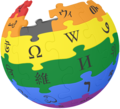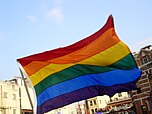| Main page | WikiProjects & Things you can do |

|
The LGBTQ+ Portal |

|

|

|
Introduction LGBT is an initialism that stands for " lesbian, gay, bisexual, and transgender". It may refer to anyone who is non-heterosexual, non-heteroromantic, or non- cisgender, instead of exclusively to people who are lesbian, gay, bisexual, or transgender. A variant, LGBTQ, adds the letter Q for those who identify as queer (which can be synonymous with LGBT) or are questioning their sexual or gender identity. Another variation, LGBTQ+, adds a plus sign "represents those who are part of the community, but for whom LGBTQ does not accurately capture or reflect their identity". Many further variations of the acronym exist, such as LGBT+ (simplified to encompass the Q concept within the plus sign), LGBTQIA+ (adding intersex, asexual, aromantic and agender), and 2SLGBTQ+ (adding two-spirit for a term specific to Indigenous North Americans). The LGBT label is not universally agreed to by everyone that it is generally intended to include. The variations GLBT and GLBTQ rearrange the letters in the acronym. In use since the late 1980s, the initialism, as well as some of its common variants, functions as an umbrella term for marginalized sexualities and gender identities. LGBT is an adaptation of LGB, which in the mid-to-late 1980s began to replace the term gay (or gay and lesbian) in reference to the broader LGBT community. When not inclusive of transgender people, the shorter LGB is still used. ( Full article...) Selected article -Various topics in medicine relate particularly to the health of lesbian, gay, bisexual, transgender, queer, intersex and asexual (LGBTQIA) individuals as well as other sexual and gender minorities. According to the US National LGBTQIA+ Health Education Center, these areas include sexual and reproductive health, mental health, substance use disorders, HIV/AIDS, HIV-related cancers, intimate partner violence, issues surrounding marriage and family recognition, breast and cervical cancer, inequities in healthcare and access to care. In medicine, various nomenclature, including variants of the acronym LGBTQIA+, are used as an umbrella term to refer to individuals who are non-heterosexual, non-heteroromantic, or non-cis gendered. Specific groups within this community have their own distinct health concerns, however are often grouped together in research and discussions. This is primarily because these sexual and gender minorities groups share the effects of stigmatization based on their gender identity or expression, and/or sexual orientation or affection orientation. Furthermore, there are subpopulations among LGBTQIA+ groups based on factors such as race, ethnicity, socioeconomic status, geographic location, and age, all of which can impact healthcare outcomes. Understanding the health of LGBTQIA+ people requires consideration of contextual factors such as historical background, stigma, laws and policies, demographics, and barriers to care, all of which are interconnected. Historical events, like laws against same-sex marriage, can impact access to health insurance for non-heterosexual individuals. Some barriers to care include a homophobia, transphobia, lack of providers trained to treat transgender patients and historical negative experiences within the healthcare system. Research shows sexual and gender minorities are more prone to psychological disorders, physical illnesses, and barriers to inclusive healthcare compared to heterosexual or cisgender individuals. The HIV/AIDS epidemic during the 1970s and 1980s, while devastating, illuminated stigma and disparities in healthcare, and the need for research funding. Today, HIV/AIDS remains a critical health issue for subgroups within the LGBTQIA+ community, particularly gay and bisexual men and transgender women, however there are many topics beyond HIV/AIDS that is effecting the health of this community. This article will discuss specific topics in healthcare for sexual and gender minorities, specifically LGBTQIA+ people, individually and collectively. ( Full article...)Selected biography -Alan Mathison Turing OBE FRS ( /ˈtjʊərɪŋ/; 23 June 1912 – 7 June 1954) was an English mathematician, computer scientist, logician, cryptanalyst, philosopher and theoretical biologist. Turing was highly influential in the development of theoretical computer science, providing a formalisation of the concepts of algorithm and computation with the Turing machine, which can be considered a model of a general-purpose computer. He is widely considered to be the father of theoretical computer science and artificial intelligence. Born in London, Turing was raised in southern England. He graduated in maths from King's College, Cambridge, and in 1938, earned a maths PhD from Princeton University. During the Second World War, Turing worked for the Government Code and Cypher School at Bletchley Park, Britain's codebreaking centre that produced Ultra intelligence. He led Hut 8, the section responsible for German naval cryptanalysis. He devised techniques for speeding the breaking of German ciphers, including improvements to the pre-war Polish bomba method, an electromechanical machine that could find settings for the Enigma machine. Turing played a crucial role in cracking intercepted messages that enabled the Allies to defeat the Axis powers in many crucial engagements, including the Battle of the Atlantic. ( Full article...)Selected quote -
Current events
Selected image -
Boy with a Basket of Fruit (1593–94) is a painting by
Caravaggio. The model was his friend and lover, the Sicilian painter
Mario Minniti, about 16 years old at the time. At one level the painting is designed to demonstrate the artist's ability to depict everything realistically, from the boy's skin to the folds of the robe to the weave of the basket. A closer look however reveals that, as in another painting by him from that time (
Basket of Fruit), the peaches have spots and the leaves are diseased, perhaps a comment by the artist on the closeness of beauty and decay in life.
Did you know… -
This month's birthdays
Selected lists
Related portalsFeatured contentThe following articles and lists have been identified as some of the
best produced by the Wikipedia community:
TopicsCategoriesAssociated WikimediaThe following Wikimedia Foundation sister projects provide more on this subject:
Discover Wikipedia using
portals |
| Main page | WikiProjects & Things you can do |

|
The LGBTQ+ Portal |

|

|

|
Introduction LGBT is an initialism that stands for " lesbian, gay, bisexual, and transgender". It may refer to anyone who is non-heterosexual, non-heteroromantic, or non- cisgender, instead of exclusively to people who are lesbian, gay, bisexual, or transgender. A variant, LGBTQ, adds the letter Q for those who identify as queer (which can be synonymous with LGBT) or are questioning their sexual or gender identity. Another variation, LGBTQ+, adds a plus sign "represents those who are part of the community, but for whom LGBTQ does not accurately capture or reflect their identity". Many further variations of the acronym exist, such as LGBT+ (simplified to encompass the Q concept within the plus sign), LGBTQIA+ (adding intersex, asexual, aromantic and agender), and 2SLGBTQ+ (adding two-spirit for a term specific to Indigenous North Americans). The LGBT label is not universally agreed to by everyone that it is generally intended to include. The variations GLBT and GLBTQ rearrange the letters in the acronym. In use since the late 1980s, the initialism, as well as some of its common variants, functions as an umbrella term for marginalized sexualities and gender identities. LGBT is an adaptation of LGB, which in the mid-to-late 1980s began to replace the term gay (or gay and lesbian) in reference to the broader LGBT community. When not inclusive of transgender people, the shorter LGB is still used. ( Full article...) Selected article -Various topics in medicine relate particularly to the health of lesbian, gay, bisexual, transgender, queer, intersex and asexual (LGBTQIA) individuals as well as other sexual and gender minorities. According to the US National LGBTQIA+ Health Education Center, these areas include sexual and reproductive health, mental health, substance use disorders, HIV/AIDS, HIV-related cancers, intimate partner violence, issues surrounding marriage and family recognition, breast and cervical cancer, inequities in healthcare and access to care. In medicine, various nomenclature, including variants of the acronym LGBTQIA+, are used as an umbrella term to refer to individuals who are non-heterosexual, non-heteroromantic, or non-cis gendered. Specific groups within this community have their own distinct health concerns, however are often grouped together in research and discussions. This is primarily because these sexual and gender minorities groups share the effects of stigmatization based on their gender identity or expression, and/or sexual orientation or affection orientation. Furthermore, there are subpopulations among LGBTQIA+ groups based on factors such as race, ethnicity, socioeconomic status, geographic location, and age, all of which can impact healthcare outcomes. Understanding the health of LGBTQIA+ people requires consideration of contextual factors such as historical background, stigma, laws and policies, demographics, and barriers to care, all of which are interconnected. Historical events, like laws against same-sex marriage, can impact access to health insurance for non-heterosexual individuals. Some barriers to care include a homophobia, transphobia, lack of providers trained to treat transgender patients and historical negative experiences within the healthcare system. Research shows sexual and gender minorities are more prone to psychological disorders, physical illnesses, and barriers to inclusive healthcare compared to heterosexual or cisgender individuals. The HIV/AIDS epidemic during the 1970s and 1980s, while devastating, illuminated stigma and disparities in healthcare, and the need for research funding. Today, HIV/AIDS remains a critical health issue for subgroups within the LGBTQIA+ community, particularly gay and bisexual men and transgender women, however there are many topics beyond HIV/AIDS that is effecting the health of this community. This article will discuss specific topics in healthcare for sexual and gender minorities, specifically LGBTQIA+ people, individually and collectively. ( Full article...)Selected biography -Alan Mathison Turing OBE FRS ( /ˈtjʊərɪŋ/; 23 June 1912 – 7 June 1954) was an English mathematician, computer scientist, logician, cryptanalyst, philosopher and theoretical biologist. Turing was highly influential in the development of theoretical computer science, providing a formalisation of the concepts of algorithm and computation with the Turing machine, which can be considered a model of a general-purpose computer. He is widely considered to be the father of theoretical computer science and artificial intelligence. Born in London, Turing was raised in southern England. He graduated in maths from King's College, Cambridge, and in 1938, earned a maths PhD from Princeton University. During the Second World War, Turing worked for the Government Code and Cypher School at Bletchley Park, Britain's codebreaking centre that produced Ultra intelligence. He led Hut 8, the section responsible for German naval cryptanalysis. He devised techniques for speeding the breaking of German ciphers, including improvements to the pre-war Polish bomba method, an electromechanical machine that could find settings for the Enigma machine. Turing played a crucial role in cracking intercepted messages that enabled the Allies to defeat the Axis powers in many crucial engagements, including the Battle of the Atlantic. ( Full article...)Selected quote -
Current events
Selected image -
Boy with a Basket of Fruit (1593–94) is a painting by
Caravaggio. The model was his friend and lover, the Sicilian painter
Mario Minniti, about 16 years old at the time. At one level the painting is designed to demonstrate the artist's ability to depict everything realistically, from the boy's skin to the folds of the robe to the weave of the basket. A closer look however reveals that, as in another painting by him from that time (
Basket of Fruit), the peaches have spots and the leaves are diseased, perhaps a comment by the artist on the closeness of beauty and decay in life.
Did you know… -
This month's birthdays
Selected lists
Related portalsFeatured contentThe following articles and lists have been identified as some of the
best produced by the Wikipedia community:
TopicsCategoriesAssociated WikimediaThe following Wikimedia Foundation sister projects provide more on this subject:
Discover Wikipedia using
portals |























